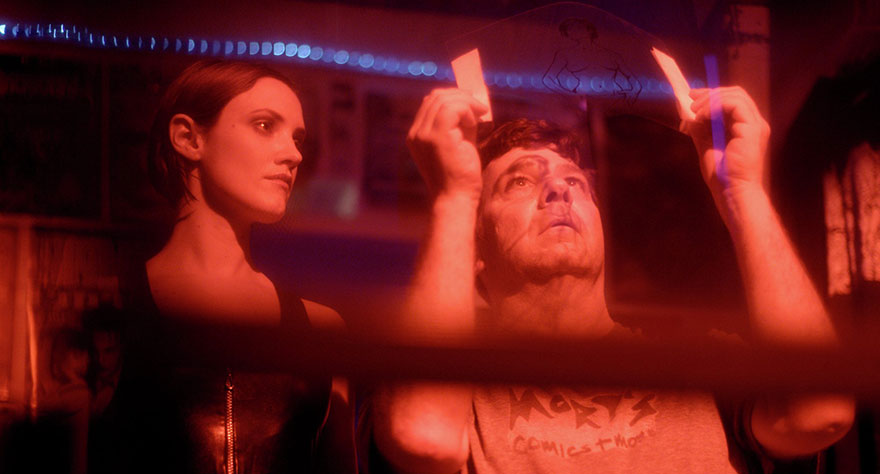
This low-key, diverting mystery film showcases a fantastic lead performance and supporting cast.

This low-key, diverting mystery film showcases a fantastic lead performance and supporting cast.
A.D. Calvo’s The Missing Girl is the unique kind of mystery film that gradually reveals itself to have no real mystery at all. That may sound like a disappointment, but in the hands of A.D. Calvo it’s quite the opposite. And while there is, in fact, a missing girl in the film (there are actually two), Calvo cleverly uses the old, familiar hook of a detective story to lure people into a character-based drama about letting go of the past and moving forward. The emphasis on character is there from frame one, but as time goes on Calvo deliberately downplays and removes his narrative strands established at the beginning to make the film’s major discovery more of an internal one for its central character. It’s the kind of low-key, diverting indie that uses its great cast to avoid falling into the clichés of a late coming-of-age tale, and it’s all elevated by an incredible lead performance.
The person at the centre of The Missing Girl is actually Mort (Robert Longstreet), a middle-aged owner of a comic book store in New London, Connecticut. He’s recently hired Ellen (Alexia Rasmussen), an aspiring graphic novelist hoping to get her work published. Mort’s attracted to the younger Ellen, but he’s too nervous to make a move. It’s soon revealed that part of Mort’s attraction to Ellen has to do with a dark memory from his past; she looks similar to his high school crush who mysteriously vanished years ago, with only her clothes and a lot of blood found underneath a bridge in a seedy-looking part of town. The unsolved mystery still bothers Mort for reasons beyond his attraction to the girl; his late father was a detective on the case and never solved it.
And then Mort’s reignited fascination with the case only gets stronger once the missing girl’s high school boyfriend Skippy (Eric Ladin) strolls into town for a few days to clean up his parents’ place after putting his dad in a nursing home. Skippy, now a rich businessman living in New York, shows he hasn’t really changed since his days in high school, coming into Mort’s shop and humiliating him in front of Ellen for his childish interests. Not too long after Ellen suddenly stops showing up for work, and when Mort goes by her place the TV’s on but nobody’s home. Suspecting that Ellen has fallen victim to a similar fate as Skippy’s former girlfriend, Mort starts investigating to find out what happened to her.
Calvo swiftly sets the pieces of his story in place, only to casually ignore the puzzle he’s laid out. Rather than add suspense by withholding the whereabouts of Ellen, Calvo leaves everything out in the open regarding her fate. It immediately deflates the sense of mystery, and by doing so allows Calvo to delve further into Mort’s life, whether it’s staying in contact with his mother (Shirley Knight), relying on his brother Stan (Thomas Jay Ryan) to help him out with his store’s finances, or getting help from his friend and local cop Fran (Sonja Sohn). Anyone familiar with these names should be aware by now that Calvo has assembled a terrific group of character actors for his film, and everyone brings their own unique presence to their roles. Even Kevin Corrigan—who’s been having a great year with roles in films like Results and Wild Canaries—shows up at one point, in what amounts to a glorified cameo.
But this is primarily a showcase for Robert Longstreet, and to say his performance makes The Missing Girl is an understatement. Longstreet, who’s been playing supporting roles over the years in films like Take Shelter, This is Martin Bonner and more recently in Josephine Decker’s Thou Wast Mild and Lovely, finally gets a chance to show off his incredible talent in a lead role. Longstreet played a terrifying, intimidating force in Decker’s film, and here, he goes in the opposite direction, portraying Mort as a meek, shy man whose obsession with comics and toys feels like a result of his inability to get over his father’s death. But Longstreet also taps into his more intense side, showing Mort as short-tempered with an ability to fly into a rage if he hears the wrong thing. It’s seriously impressive how much Longstreet transforms Mort from the standard image of a man in arrested development to a fascinating and complex person.
Behind the camera, Calvo and cinematographer Ava Berkofsky give the film a rare quality seen in recent indies that takes advantage of the film’s New London setting (or maybe it’s just refreshing to see something not in Brooklyn or Los Angeles). Michael Taylor’s editing is where The Missing Girl shows off some originality by using split screens and match cuts to make the screen reflect comic book panels, but its implementation is hit and miss (the first time it’s used might be the best part since the effect is somewhat disorienting). Similarly, Calvo’s brief glimpses into Mort’s brain through fantasy sequences also don’t land too well, adding a crudeness to the film that doesn’t match up well with everything else. But Calvo’s film is primarily a character study, and on that end it succeeds thanks to Longstreet. It’s a mystery movie with no real resolution, and in this case, there’s nothing wrong with that.